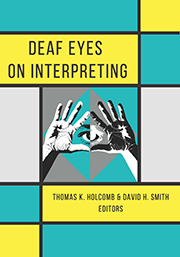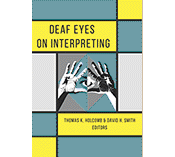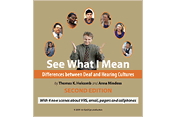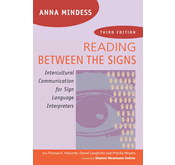 Anna:
Anna:
As long as there have been Deaf people on earth, they have helped each other by explaining or interpreting to ensure that all members of the Deaf community have access to information. This often-overlooked facet of Deaf culture is currently receiving much well deserved attention in a variety of settings. In a new book, Deaf Interpreters at Work: International Insights, published by Gallaudet University Press, four distinguished editors and 17 contributors document the historical roots and current practices of Deaf interpreters in Australia, Canada, England, Finland, Ireland, Sweden and the United States .
While the professionalization of hearing people earning their living as sign language interpreters has eclipsed the traditional role played by Deaf people within their own society, there is currently a momentum for Deaf interpreters (DIs) to reclaim this traditional cultural role and work alongside hearing interpreters in the hospital, courtroom or on the conference stage.
In the Introduction to Deaf Interpreters at Work, the co-authors acknowledge that while DIs and hearing interpreters both follow a formalized code of conduct, there are crucial differences between them, including “the fact that DIs are Deaf all of the time…[consequently] DI and hearing interpreters have dissimilar access to information; DI and hearing interpreters have a different relationship with Deaf culture in that the former have more confidence in their position in that culture than do the latter.” The authors also describe a division of strengths: “DIs have a better understanding of sign language nuances, hearing interpreters have a better understanding of spoken language nuances…” (Adam et al. 2014, 7).
Deaf and Hearing Interpreters Can Work Together Effectively
In my own work specializing in legal interpreting for the past 20 years, I have had the privilege and pleasure to work with many highly skilled and creative CDIs (Certified Deaf Interpreters) in an array of challenging situations. I believe that this configuration can often achieve a deep accuracy not possible when hearing interpreters work alone.
For Deaf and hearing interpreters to work together successfully, however, they need training in a specific type of teamwork. Last week, I attended a three-day intensive conference in Denver which focused on Deaf and hearing interpreters working together effectively in the legal setting. The turnout at the ILI (Institute for Legal Interpreting) demonstrated a historical show of strength and a growing acknowledgement of the necessity for and power of Deaf interpreters. Of the 220 attendees, there were 54 CDIs from across the country. For more details see this post on Street Leverage.
Speaking of history, the attendees at ILI were treated to a fascinating presentation by Anne Leahy, a graduate student in Salt Lake City, who shared her historical research on Deaf interpreters being used in several court cases going back to the mid 1800’s. I look forward to Anne publishing these intriguing stories when her research is complete.
Recently, on the website Street Leverage, I issued a challenge to hearing interpreters to accept their pivotal position as “first responder.” When we are called to an interpreting assignment and must make the decision whether to halt the proceedings until a Deaf interpreter can be summoned, we truly hold the key to ensuring the most effective access to information for all parties involved. Here is a excerpt from my article:
Deaf interpreters are marching up the road to take their place as equal and valued professionals alongside their hearing counterparts. As more Deaf interpreters are trained, become certified and collaborate with hearing teammates, it will inevitably alter our way of working. We can welcome this evolving development and cherish the new opportunities it brings or dig in our heels and resist.
[Click to view post in ASL]
Two Street Leverage posts have addressed the gathering momentum of this movement. In Deaf Interpreters in the Blind Spot of the Sign Language Interpreting Profession, Jennifer Kaika documents the increasing numbers of Deaf interpreters and challenges us to support Deaf interpreters as “a long-standing and lasting part [of our profession], present since the inception of RID.” In Deaf Interpreters: The State of Inclusion, Nigel Howard, a Deaf interpreter himself, urges us to truly realize a team approach by “working together toward a shared and collaborative target language interpretation that is an equivalent to the source language.”
Recently, when revising my book, Reading Between the Signs, for a new edition, I added a section on Deaf interpreters. With the book’s focus on the cultural aspects of our work, it struck me that the resistance some hearing interpreters seem to feel to this “new” development in our field, might be rooted in cultural values (more about this later). First, let’s confirm the fact that Deaf interpreters belong to a tradition with deep roots.
LONG TRADITION
Eileen Forestal, a Deaf interpreter who has been at the forefront of research and training, contributed a chapter to the new book, Deaf Interpreters at Work: International Insights. While awarding official certificates to Deaf interpreters may be a relatively recent development, Forestal writes that, “as long as Deaf people have existed, they have been translating and interpreting within the Deaf community.” It goes back to the residential schools, where “Deaf children, both in and out of the classroom, would frequently explain, rephrase, or clarify for each other the signed communication used by hearing teachers.” Once out of school, this supportive activity did not cease. “Deaf persons would interpret for each other to ensure full understanding of information being communicated, whether in classrooms, meetings, appointments, or letters and other written documents” (Forestal, 2014, 30).
MY EXPERIENCE
Researching the history of Deaf interpreters allowed me to look back at my own career and see it through different eyes. After discovering the Deaf World via theater in the mid 1970’s when I was an actress in Los Angeles, I found CSUN where I took all four(!) classes offered at the time: ASL 1 and 2 and Interpreting 1 and 2.
Clearly, I was not prepared to work as a sign language interpreter, but with encouragement from my Deaf theater friends, I cautiously began community interpreting. In hindsight, I recall that at several Social Security or VR appointments, the Deaf person I was supposed to meet brought a “Deaf friend.” And if my interpretations were not clear enough, the friend would succinctly convey the point, assuming the role of unofficial “Deaf interpreter.”
In the mid-1980’s, I got a full time job at a large TDD distribution center in downtown Los Angeles to handle the crush of new customers thrilled to get the latest communication devices. When walk-in customers arrived, my co-worker, a Deaf woman named Sue Lee, would greet them and demonstrate their choice of equipment. My job was to interpret the registration process between Deaf customers and the hearing phone company reps on-site. As LA is a city of immigrants, it often happened that the Deaf person and I needed some extra help going over the rules of the program. I’d ask Sue to join us and she would come up with a way to best convey the information. Once again, everyone benefitted from the skills of a “Deaf interpreter,” although we didn’t label it as such at the time.
After moving to the San Francisco Bay Area, I continued community interpreting, but returned to CSUN in 1991 for a 6-week course in legal interpreting. Our class of two-dozen seasoned interpreters included 3 Deaf interpreters and we enjoyed figuring out how to best work together in the legal scenarios we practiced.
Over the last 20 years, I’ve specialized in legal interpreting and often team with Deaf interpreters (now CDIs). Most of my peak moments interpreting have occurred while collaborating with a Deaf interpreter to achieve the shared goal of optimal understanding. To me, it feels like dancing with the perfect partner. Having the benefit of teaming together repeatedly, we can often anticipate each other’s needs and intentions and seamlessly move as one.
For a new chapter in my book, I interviewed five very skilled Deaf interpreters with whom I have had the privilege and pleasure of working in court: Linda Bove, Daniel Langholtz, Priscilla Moyers, Ryan Shephard and Christopher Tester.
WHAT WE FOUND…
“Article originally appeared on www.streetleverage.com. Reprinted with permission of Street Leverage.”
For more information on Deaf Interpreters check out the Deaf Interpreter Institute: http://www.diinstitute.org
 This is the sixteenth weekly installment featuring highlights from the 20 chapters in the new book, Deaf Eyes on Interpreting, edited by Thomas K. Holcomb and David H. Smith which was released in June by Gallaudet University Press.
This is the sixteenth weekly installment featuring highlights from the 20 chapters in the new book, Deaf Eyes on Interpreting, edited by Thomas K. Holcomb and David H. Smith which was released in June by Gallaudet University Press.







